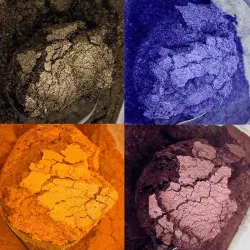The Science Behind Metallic Pigments and Their Growing Use in Modern Design
2024-09-29
Metallic pigments have transformed the way products are designed, offering a unique combination of aesthetics, durability, and functionality. From the automotive industry to high-end packaging and cosmetics, metallic pigments have become a key element in creating striking and durable finishes. But what is it about these pigments that makes them so special? In this blog, we’ll dive into the science behind metallic pigments and explore their growing use in modern design.
How Do Metallic Pigments Work?
Metallic pigments work by reflecting light off their flat, metallic surfaces, giving off a distinct shine that mimics the look of metal. The particles are typically made from metals like aluminum, copper, or bronze, which are ground down into tiny flakes. These flakes align themselves when applied to a surface, creating a smooth, reflective layer.
When light hits this surface, it bounces back in different directions, producing a shiny, metallic effect. This reflective property is what sets metallic pigments apart from regular pigments, which simply absorb or diffuse light without creating that iconic metallic luster.
The Technology Behind Metallic Pigments
Modern metallic pigments are produced using advanced manufacturing processes to ensure consistency, durability, and shine. Here are some of the technologies involved:
1. Vacuum Metallization: This technique involves vaporizing metal in a vacuum chamber and condensing it onto a surface. The result is an ultra-thin, even layer of metal that can be ground into fine pigments. This method is commonly used to produce aluminum pigments, which are prized for their high reflectivity.
2. Nano-Technology: Some metallic pigments are created using nano-sized metal particles. These ultra-small particles offer improved coverage and a smoother finish, making them ideal for high-end applications like luxury car coatings or premium cosmetics.
3. Encapsulation: To prevent oxidation and ensure stability, metallic pigments are often coated with protective layers. This process, called encapsulation, ensures that the pigments maintain their shine and don’t degrade over time, even when exposed to environmental factors like humidity and UV light.
Uses in Modern Design
1. Packaging Design
Metallic pigments are increasingly being used in packaging design to give products a premium feel. From perfume bottles to food packaging, a touch of metallic shine adds elegance and attracts consumer attention. Brands use metallic pigments in logos, labels, and other packaging elements to create a sense of luxury and exclusivity.
2. Interior Design
Metallic pigments are now a popular choice in interior design, where they’re used in paints, wallpapers, and furniture finishes. The reflective properties of metallic pigments can brighten up a room and create a sophisticated, modern atmosphere. Designers often use metallic finishes for feature walls, light fixtures, or accent pieces, adding an element of glamour to the space.
3. Cosmetic Industry
In the beauty industry, metallic pigments are used in everything from eyeshadows to highlighters. These pigments provide the rich, glowing finish that is often sought after in cosmetics, especially for bold, nighttime looks. Beyond makeup, metallic pigments are also used in nail polish, hair products, and body lotions, providing a radiant, eye-catching effect.
4. Fashion and Textiles
In the world of fashion, metallic pigments are being used in textiles to create futuristic, high-shine fabrics. From runway designs to everyday clothing, metallic pigments add drama and intrigue. Metallic finishes on fabrics are particularly popular for evening wear, accessories, and footwear, where the shiny surface makes a bold fashion statement.
Environmental Considerations
While metallic pigments offer significant aesthetic and functional benefits, there are environmental considerations to be aware of. Traditional metallic pigments, particularly those containing heavy metals like lead, can be harmful to both human health and the environment if not properly managed. As a result, many manufacturers are now shifting towards safer, eco-friendly alternatives.
- Water-Based Metallic Pigments: These pigments are designed to reduce the environmental impact, using water as a solvent instead of harmful chemicals. They offer similar aesthetic properties without contributing to pollution or health risks.
- Non-Toxic Metallic Pigments: Many industries are now opting for non-toxic metallic pigments that are free of harmful metals like mercury and cadmium. These pigments provide the same high-quality finish without the risk of environmental contamination.
Conclusion
Metallic pigments are not just a trend; they are a revolution in modern design. Whether in packaging, cosmetics, or interior decor, these pigments offer endless possibilities for creating products that stand out. The science behind metallic pigments allows for innovative uses and ensures that they are durable, safe, and effective. As technology continues to advance, the applications for metallic pigments will only grow, bringing even more brilliance to the world of design.



